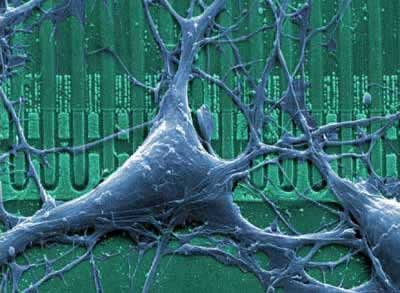| Posted: Oct 05, 2016 |
Memristors promise more precise and affordable neuroprosthetics
(Nanowerk News) In a new paper ("Memristive integrative sensors for neuronal activity"), researchers from the University of Southampton, UK, and members of the EU-funded RAMP project, have demonstrated howmemristors could help aid the development of more precise and affordable neuroprosthetics and bioelectric medicines.
|
 |
| Natural neuronal network grown on a silicon microchip allowing high resolution recording and stimulation of neurons.
|
|
Monitoring neuronal cell activity is fundamental to neuroscience and the development of neuroprosthetics but a persistent problem is the device being able to effectively process the neural data in real-time, which in turn imposes restrictive requirements on bandwitdth, energy and computation capacity.
|
|
The solution to this problem, according to scientists working as part of the RAMP (Real neurons-nanoelectronics Architecture with Memristive Plasticity) project could lie with the use of memristors. These are electrical components that limit or regulate the flow of electrical current in a circuit and can remember the amount of charge that was flowing through it and retain data, even when the power is turned off. In essence, they perform a role akin to biological synapses and possess the intrinsic ability to simultaneously carry out computational tasks and store information at aggressively downscaled volumes and power dissipation.
|
|
Lead author Isha Gupta, a postgraduate research student at Southampton University, commented: ‘Our work can significantly contribute towards further enhancing the understanding of neuroscience, developing neuroprosthetics and bio-electronic medicines by building tools essential for interpreting the big data in a more effective way.’
|
|
The research team developed a nanoscale Memristive Integrative Sensor (MIS) into which they fed a series of voltage-time samples, which replicated neuronal electrical activity. By acting like brain synapses, the metal-oxide MIS was reportedly able to encode and compress (up to 200 times) neuronal spiking activity recorded by multi-electrode arrays. Besides addressing the bandwidth constraints, the researchers claim that this approach is also very power-efficient in that the power needed per recording channel was up to 100 times less when compared to current best practices.
|
|
‘We are thrilled that we succeeded in demonstrating that these emerging nanoscale devices, despite being rather simple in architecture, possess ultra-rich dynamics that can be harnessed beyond the obvious memory applications to address the fundamental constraints in bandwidth and power that currently prohibit scaling neural interfaces beyond 1 000 recording channels,’ said co-author Dr Themis Prodromakis.
|
|
The work undertaken by the RAMP team is a highly promising leap forward for addressing a diverse number of diseases and conditions from which the development of sophisticated neuroprosthetics promise to significantly reduce symptoms and increase quality of life for patients. One of the biggest challenges in this field has been to ensure that neuroprosthetics have the ‘feel’ of being a part of the patient’s own body or, for prosthetics located in or on certain parts of the body, are non-invasive.
|
|
Through the RAMP consortium, engineers from Southampton were able to link with biologists from the University of Padova, Italy, and the Max Planck Institute, Germany, using the facilities of the Southampton Nanofabrication Centre.
|
|
The RAMP project, which received just over EUR 2 million in EU-funding, is due to end in October 2016.
|

